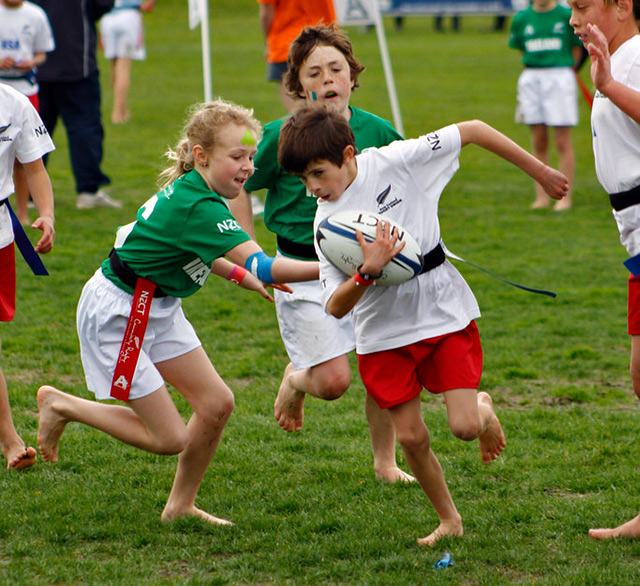
Tag Rugby, also known as Flag Rugby, is a team sport based on Rugby Union. In tag rugby, instead of a tackle, a tag attached to the player via vecro strips are pulled off the ball carrier. It is similar to Touch Rugby in which the tackle is replaced by only a touch. These sports are used in the development of the full-contact Rugby League and Rugby Union codes.
In Tag Rugby, attacking players attempt carry and pass a rugby ball to the scoring zone at the end of the field, while defenders attempt to prevent them scoring by "tagging" – pulling a velcro attached tag from the ball carrier.
It is played in several forms around the world, such as Rippa Rugby, Try Tag Rugby, OzTag and Mini Tag. OzTag is a non-contact form of rugby league.
 tag rugby game
tag rugby game American Flag Rugby played in the US K1-9 is a variation of Tag Rugby. American Flag Rugby is currently split into four divisions based on grade level, to facilitate children to play within their age group and skill level. Matches are played between two teams, with 7 players on each side for two 10 minute halves. The field size and the rules of the sport are different for children playing in different divisions: Owls (players from KG to 1st grade), Falcons (players from 2nd and 3rd grades), Hawks (players are from 4th to 6th grades) and Eagles (players are from 7th to 9th grades). The field size gradually increases for higher divisions. The lowest division will have very basic rules, and additional rules are included for each higher division.
Similar Sports
- Touch Rugby — a team sport derived from Rugby Football, in which the tackling is replaced with just a touch.
- Mini Rugby — a modified version of rugby union, to make the sport suitable to be introduced to children.
- Flag Football — similar to American football but instead of tackling players the defensive team have to remove a flag from the ball carrier.
- Touch Football — A version of American Football, where instead of tackling players to the ground, the person carrying the ball only needs to be touched.
Related Pages
- Complete list of sports
- Football Decoder — variations of what is called football around the world
- The Encyclopedia of Sports


 Current Events
Current Events